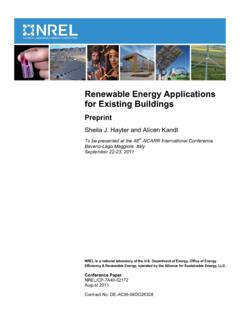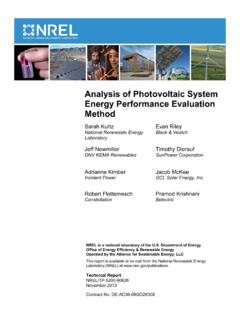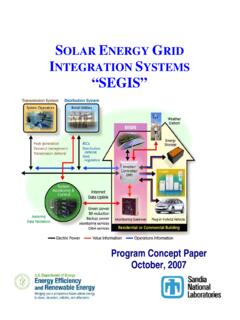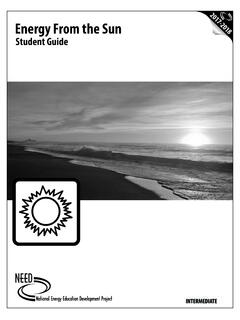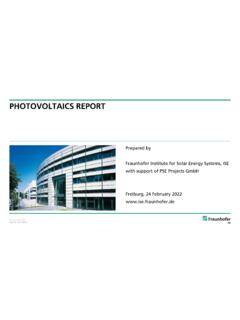Transcription of Electrolysis of Water - Energy
1 DEPARTMENT OF Energy Efficiency & Energy EDUCATION AND WORKFORCE DEVELOPMENTR enewable EnergyENERGY Electrolysis of Water Grades: 5-8 Topic: Hydrogen and Fuel Cells, Solar Owner: Florida Solar Energy Center This educational material is brought to you by the Department of Energy s Office of Energy Efficiency and Renewable Energy . High- Energy Hydrogen I Teacher Page Electrolysis of Water Student Objective Key Words: The student: compound will be able to explain how hydrogen Electrolysis can be extracted from Water hydrogen will be able to explain how Energy molecule flows through the Electrolysis system oxygen Materials: photovoltaic cell (3V min) or 9-volt Time: battery (1 per group) 1 hour piece of aluminum foil, approx.
2 6 cm x 10 cm (2 per group) salt electrical wires with alligator clips (2 per group) beaker or small bowl (1 per group) Water stirring rod or spoon graduated cylinder (several per class) Science Journal Background Information When you add salt to the Water , the salt ions (which are highly polar) help pull the Water molecules apart into ions. Each part of the Water molecule (H O) has a charge. The OH- ion is 2 negative, and the H+ ion is positive. This solution in Water forms an electrolyte, allowing current to flow when a voltage is applied.
3 The H+ ions, called cations, move toward the cathode (negative electrode), and the OH- ions, called anions, move toward the anode (positive electrode). Bubbles of oxygen gas (O ) form at the anode, and bubbles of hydrogen gas (H ) 2 2 form at the cathode. The bubbles are easily seen. Twice as much hydrogen gas is produced as oxygen gas. The net reaction: 2H O 6 2H + O2 22 Procedure (prior to class) 1. Make up one set of experimental apparatus that the students may use as a model during their experiments. Florida Solar Energy Center Electrolysis of Water / Page 1 Procedure (during class) 1.
4 Read the following passage to the students (This passage also appears on the student's science journal): Electrolysis is a technique used by scientists to separate a compound or molecule into its component parts. By adding electricity to Water and providing a path for the different particles to follow, the Water can be separated into hydrogen and oxygen. In this experiment you will be taking a sample of salt Water and add a flow of electricity to it (the Electrolysis ). You will see the hydrogen and oxygen bubbling up. 2. Divide the students into lab groups of 3 - 4 students per group.
5 Give the students an overview of what they will be doing. Then break it down into smaller steps, explain each procedure and have the groups work simultaneously. The students will: Accordion-fold each piece of aluminum foil down the long way so that you have two pieces approximately 1 cm x 6 cm. These are going to be your electrodes Press each electrode flat Bend the top 1 cm of each electrode over to act as a hanger Dissolve salt into Water at the ratio of one teaspoon salt for each 50 ml of Water . Stir to dissolve the salt Hang the electrodes on the inside of the bowl so that they hang down into the Water .
6 They should hang a couple inches apart--do not let them touch during the experiment. Add more salt Water if necessary Attach one end of each wire to the hanger of your electrode Attach the other end of each wire to your photovoltaic panel or a battery. Make a note which electrode is attached to the positive and which is attached to the negative terminal of your battery If using photovoltaics, take your Electrolysis device outside into the Sun. 3. Assist students as needed during the experiment. 4. Lead a discussion on the student s observations and the significance of their observation.
7 Points to cover may include: The process that they observed was the breaking apart of the molecules of Water (by using electrical Energy ) into its parts: hydrogen and oxygen The chemical formula for Water is H O (students may have heard this previously 2 and not understood what it meant). Explain that it means that Water is a molecule that is a combination of hydrogen and oxygen. The two means that there are two atoms of hydrogen to every atom of oxygen The hydrogen and oxygen produced were gases. (Can Water be a gas also? How?)
8 The process that they observed could be reversed. Oxygen and hydrogen can be combined to produce Water and electricity. The apparatus used to do this is called a fuel cell. Hydrogen is used as a combustible fuel on the Space Shuttle, and can also be used to make electricity with a fuel cell. 5. Students should complete the questions in their Science Journal Florida Solar Energy Center Electrolysis of Water / Page 2 Further Research 1. How does varying the concentration of the salt Water affect the number of bubbles produced by the electric current?
9 2. How does varying the amount of electricity in the hydrolysis circuit affect the amount of gas being produced? 3. How could you capture and measure the amount of gas produced? 4. Where is hydrogen currently being used in the state of Florida? How much is used per year? Where is it produced? Related Reading Hydrogen Power of the Future: New Ways of Turning Fuel Cells into Energy by Chris Hayhurst (Rosen Publishing, 2003) This book discusses the pros and cons of using hydrogen power to help fight air pollution and meet our growing demand for electricity.
10 The Story of Hydrogen by Mark Uehling and Frank Watts (Franklin Watts, 1995) Discusses the discovery, nature, behavior, and uses of the element hydrogen. Henry Cavendish & The Discovery of Hydrogen by Josepha Sherman ( Mitchell Lane Publishers, 2005) The strange little man was unnaturally shy. He couldn t stand looking anyone in the face. He was unable to bear meeting more than one person at a time, and ran away if too many people came near him. When he had to go out, he sat in the shadows of his carriage so that no one could see him.












